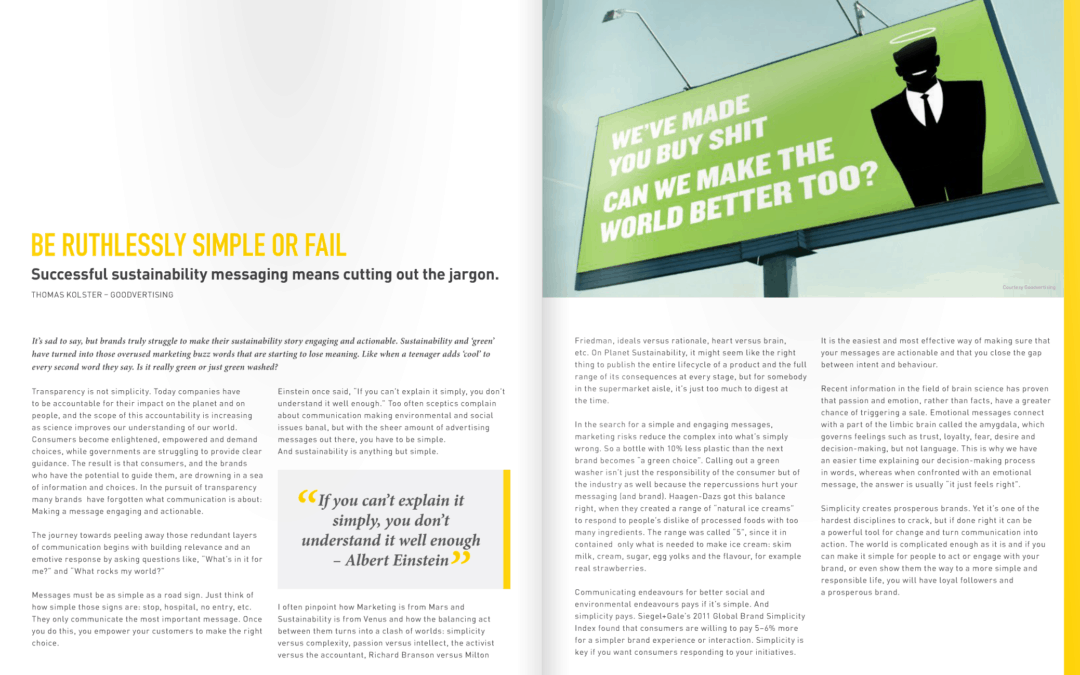Successful Sustainability Messaging Demands You Be Simple
It’s sad to say, but brands truly struggle to make their sustainability story engaging and actionable. Sustainability and ‘green’ have turned into those overused marketing buzz words that are starting to lose meaning. Like when a teenager adds ‘cool’ to every second word they say. Is it really green or just green washed? The world is complex enough as it is, so ask yourself the question: Can this be said or done more simply?
Transparency is Not Simplicity
There is growing pressure on companies to be more accountable for their impact on the planet and on people, and the scope of this accountability is continuing to expand as science improves our understanding of the world around us. Consumers become enlightened, empowered and demand choices, and at the same time governments are struggling to provide clear guidance. The result seems to be that consumers are drowning in information and choices – and the brands that have every potential to guide consumers are getting lost themselves in the information jungle. In the pursuit of transparency it seems like brands have forgotten what communication is about: Making a message engaging and actionable. The journey towards peeling away those redundant layers of communication begins with building relevance and an emotive response by asking questions like, “What’s in it for me?” and “What rocks my world?”
Make your Message Simple as a Road Sign
Think of simplicity as road signage: Turn left, hospital, road works ahead. Simplicity leaves out the details and communicates the single most important message. Only then can you empower your customers or your other stakeholders to make the right choice. Einstein once said, “If you can’t explain it simply, you don’t understand it well enough.” Too often skeptics complain about communication making environmental and social issues banal, but with the sheer amount of advertising messages out there, all demanding attention, you have to be simple. And sustainability is anything but simple.
Marketing is from Mars, Sustainability is from Venus
I often pinpoint how Marketing is from Mars and Sustainability is from Venus and how most of the time the balancing act goes wrong and turns into a clash of worlds: simplicity versus complexity, passion versus intellect, the activist versus the accountant, Richard Branson versus Milton Friedman, ideals versus rationale, heart versus brain. On planet sustainability it might seem like the right thing to publish the entire lifecycle of a product and the full range of its consequences at every stage, but for somebody who spends less than 2 seconds in the supermarket aisle, it offers nothing but chaos like those hard-to-decipher E numbers on that bag of candies.
Simple or Simply Wrong?
In the search for a simple, engaging message marketing risks reducing the complex into what’s simply wrong, so a bottle with 10% less plastic becomes “a green choice”. I’ll encourage the industry to self-regulate, calling out a green washer shouldn’t only be left to consumers, but to the industry alike, because the repercussions hurt your messaging (and brand). Haagen-Dazs got the balance right, when they wanted to promote a series of “natural ice creams” to respond to people’s dislike of processed foods with too many ingredients. They called the series “5”, because every ice cream only consisted of what makes up an ice cream “skim milk, cream, sugar and egg yolks” plus a fifth ingredient adding the flavour, for example strawberries.
Sustainability Pays, if Simple
And it pays to be simple. Siegel+Gale’s Global Brand Simplicity Index from 2011 of 6,000 consumers around the world found that consumers are willing to pay 5–6% more for a simpler brand experience or interaction. If you want people to respond to your initiatives, simplicity is a way of making sure that your messages are actionable – that you close the gap between intent and behaviour. Who said consumers aren’t willing to pay more for sustainable products? Maybe your message wasn’t simple enough?
Make Your Message Emotional
Recent brain science has found evidence that messages from brands that convey passion and emotion, rather than facts, have a greater chance of triggering a sale. Emotional messages connect with a part of the limbic brain called the amygdala, which governs feelings such as trust, loyalty, fear and desire and, more importantly, decision-making, but not language. That’s why we have an easier time explaining our decision-making process in words, whereas when confronted with an emotional message there is seldom a better answer than, “it just feels right”.
Take the rapid growth of brands playing on localism, there might not be a rational argument why that brand should be more sustainable than for example a brand from a multinational, but with a local farmer on the packaging there is no need for a CSR report. trust comes with a first name. You have to be aware if you’re trying to solve an emotional problem such as lack of trust with a rational solution. McDonalds can be as transparent as they want, but if people simply don’t trust them it doesn’t make a difference. It’s like in a relationship where the trust has been lost, words don’t suffice you must show clear actions and care.
Simplicity Creates Prosperous Brands
Simplicity is one of the hardest disciplines to crack, but if done right it can be a powerful tool for change, turning communication into action. The world is complicated enough as it is and if you can make it simple for people to act or engage with your brand or cause, or even show people the way to a more simple and responsible life, you will have loyal followers and a prosperous brand.

